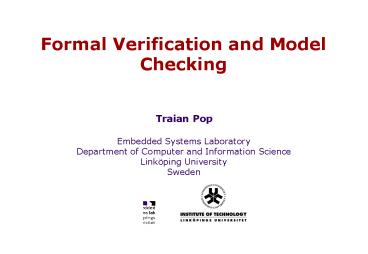Formal Verification and Model Checking PowerPoint PPT Presentation
Title: Formal Verification and Model Checking
1
Formal Verification and Model Checking
- Traian Pop
2
System Validation
- System Validation Techniques
- Simulation
- Testing
- Formal Verification
- Model Checking
3
Simulation
- Based on executable model of the system
- permits a quick and shallow evaluation of the
design quality - not suitable for finding subtle errors
4
Testing
- based on the real implementation of the system
not on a model - it is the only way of (partially) validating a
design when - the construction of a valid and reliable model of
the system is difficult (due to complexity) - system parts cannot be formally modelled
- the model is proprietary
5
Formal Verification
- Formal Verification requires
- A model of the system
- A specification method
- A set of proof rules
6
Formal Verification (contd)
- Verification of sequential programs
- pre- and post-conditions f S y (Hoares
triple) - f S y is partially correct if any terminating
computation S that starts in a state satisfying
f,terminates in a state satisfying y. - f S y is totally correct if any computation S
that starts in a state satisfying f,terminates
and finishes in a state satisfying y.
7
Formal Verification (contd)
8
Formal Verification (contd)
- Formal verification of parallel systems
introduces non-determinsm problems - Tools in formal verification
- Proof assistants
- Proof checkers
- Theorem provers
9
Model Checking
- Automated technique
- Verifies whether the required properties hold for
a model
10
Model Checking (contd)
- Typical algorithm exhaustive state-space search
- Approaches (depending on requirement
specificaton) - Heterogeneous (logic based)
- Homogeneous (behavior based)
- Bisimulation (A and B are bisimilar if A can
simulate every step of B and vice-versa) - Two bisimilar models satisfy the same CTL formulas
11
Computational Tree Logic (CTL)
- Specification language for finitestate systems
- Each formula describes properties of computation
paths (which are infinite sequences of states) - Logical operators NOT, AND
- Operators for temporal relationships X
(next-state), G(global), U(until), F(future) - Path quantifiers E, A
12
Computational Tree Logic (contd)
- Descriptions
- Xf holds for a path p iff it holds for
succ(first(p)) - Gf gtf holds in all states of a computational
path - Ff gt f will hold sometime in the future
- fUg holds for p if there exists a state s on p
where g holds while f holds in all states
preceding s - AXf holds in a state if f holds in all possible
next states
13
Binary Decision Diagrams (BDD)
- Rooted, acyclic graphs representing boolean
functions - Capture some of the regularities in the
state-space - Total ordering on variables is needed
- Support AND, OR, NOT and functional composition
14
Model Checking with BDDs and CTL
f V g BDD(f) V BDD(g)
NOT f NOT BDD(f)
BDD(EX, f, R)(vi) ? vf R(vi, vf) ? BDD(f,R)(vf)
Ef U g z g V f ? EXz
EGf z f ? EXz
15
Fairness
- Fairness constraint an arbitrary formula of the
logic - A path is fair with respect to a set of fairness
constraints if each constraint holds infinitely
often along the path - CTLF enhanced for dealing with fair paths
- Ex.
- Fair EG true
- EX f ? EX(f ? Fair)
- EG f with B ? Z f ? EX(EZ U (Z ? B))
16
Model Checking for RTS
- Extend both the state-transition graph and the
logical formulas, with quantitative timing
information - TCTL (Timed CTL) expresses desired behavior
- Timed graphs express possible behavior
17
Timed CTL
- E f Uc g
- A f Uc g
- ??, ?, ?, ?, ?
- E f U ? c g for some computational path p
there is an initial prefix of time less than c
such that g holds at the last state and f holds
in all intermediate states - ! No X operator for time in real domain R, as
there is no unique next-state/next-time
18
Timed graphs
- Model finite-state RT systems
- Composed of
- Finite set of nodes
- Finite set of clocks
19
Model Checking for RTS (contd)
- The problem consists of deciding whether a
finite-state RTS modelled as a timed graph meets
its specification given as a TCTL-formula - System model G (S, m, s0, E, C, p, t)
- TCTL-structure MG (S x G(G), m, f)
- For a TCTL-formula f, G satisfies f iff (MG,
,(s0, u0)) satisfies f, where u0(x) 0, ? x ? C
20
Model Checking - Conclusions
- Advantages
- General approach
- Supports partial verification
- Relatively easy to use (as compared to theorem
provers) - Can provide a significant increase in the level
of confidence of a system - Disadvantages
- Appropriate mainly to control intensive
applications - Verifies the model, not the system
- Only stated requirements are checked
- State-space explosion problem -gt complexity issues

